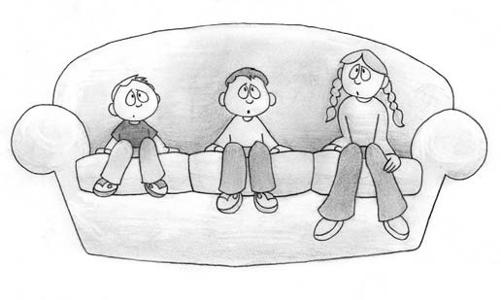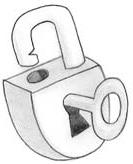The 1-2-3 Magic Workbook for Christian Parents: Effective Discipline for Children 2-12 (13 page)
Read The 1-2-3 Magic Workbook for Christian Parents: Effective Discipline for Children 2-12 Online
Authors: Thomas W. Phelan,Chris Webb
Tags: #Family & Relationships, #Parenting, #General

time out starts after two hours.
And don’t be sticking your head in there every five or ten minutes
saying things like, “Come on now, don’t you think that’s enough? We
miss you. Dinner’s in five minutes and you have homework to do....” Just
leave him alone until he’s tired of being angry.
The only children we don’t use this temper-tantrum modification for
are the two- and three-year-olds. They don’t seem to get the idea, so just
let them out after a couple of minutes, even if they’re still tantruming, and
cross your fingers. Once they’re out, ignoring the child is usually more
effective than trying to talk him out of his irritation. If he still doesn’t
quiet down, leave him in a little longer the next time.
Pouting
Pouting is a passive behavior that is designed to make you feel guilty. If
you do wind up feeling guilty when your child pouts, that’s really more

66 1-2-3 MAGIC
your problem. Why should you feel bad for trying to be a good parent,
just because your youngster didn’t like the demand or restriction you
placed on her? You shouldn’t.
So if you discipline a child and she gives you the ultimate in martyr
looks, just turn around, say nothing and walk away. The only time you
would do something different is if you get what we call an “aggressive
pouter.” An aggressive pouter is a child who follows you all over the house
to make sure you don’t miss a minute of the sour face. If she does that,
“That’s 1.” She’s trying to rub your nose in her grumpiness, and you’re
not going to allow her to do that.
Points to Remember
1. SIBLING RIVALRY: Count both kids most of the time.
2. TEMPER TANTRUMS: The time out doesn’t start until after
the tantrum is over.
3. POUTING: Pouting can be ignored unless the child becomes
an “aggressive pouter.”

9
The Kickoff Conversation
The kids will look at you like you’ve
just lost your mind.
Getting started with the 1-2-3 is pretty easy. The Kickoff Conversa-
tion, in which you explain the new regime to the children, only
takes about five to ten minutes. Even though it’s a bit like a little-adult-
type explanation, you should give the kids the benefit of the doubt and
tell them what you’ll be doing. But don’t put a lot of stock in the impact
of this initial conversation. Wishful thinking on your part will not do the
job. Lots of children don’t really get the idea until you’ve been counting
for a while and they’ve been to their rooms a few times.
If both parents are living at home, or even if mom and dad live in
separate places, it’s preferable if both grownups sit down together with
the youngsters and do the initial explaining.
Here’s what you say:
“Listen, you guys know there are times when you do things we don’t
care for, like arguing, whining and teasing. From now on we’re going to
do something a little different. When we see you doing something you’re
not supposed to, we’ll say, ‘That’s 1.’ That’s a warning, and it means
you’re supposed to stop. If you don’t stop, we’ll say, ‘That’s 2.’ That will
be your second warning. If you still don’t stop, we’ll say, ‘That’s 3, take
67

68 1-2-3 MAGIC
5 (or however many minutes equals your age).’ That means you have to
go to your room for a time out or a kind of rest period. When you come
out, we don’t talk about what happened unless it’s really necessary. We
just forget it and start over.
“By the way, kids, there’s part of this new system that you’ll like
and part you won’t like. Here’s what you won’t like: If the thing you do
is bad enough to start with, like swearing or hitting, we’ll say, ‘That’s 3,
take 10 or 15.’ That means there aren’t any other warnings, you just go
straight to your room, and the time will be longer.
“The part you will like is that most of the time we won’t talk about
what happened after a time out. Well, that’s the new deal. It’s pretty simple.
Do you have any questions?”
The Children’s Reaction
Expect the kids to sit there and look at you like you’ve just gone off
your rocker. Some kids will poke each other and
exchange knowing glances, as if to say, “Well,
Quik Tip…
it looks like Mom went to the library again and
Don’t expect the
children to thank got another one of those books on how to raise
you or look
us guys. Last time she stuck to it for about four
enlightened after the
days, and Dad never did anything different at
Kickoff Conversation.
all. I think if we stick together and hang tough,
Some kids will be puzzled
and others won’t believe
we should be running the house again inside of
you’re serious. You’ll soon a week, right?”
make believers out of
Wrong. Don’t expect the children to be grate-
them, though, by your
ful, to look enlightened or to thank you for your
consistent, gentle and
decisive follow-up.
efforts to raise them responsibly. Just get going,
stick to your guns and—when in doubt—count!
What about two- and three-year-olds who
won’t understand an initial explanation? You have two options. Just start
counting and doing time outs. Little kids are much smarter than we often
give them credit for. They’ll get the idea quickly.
Or, if two parents are living at home, try a little role playing. Dad
pretends he’s acting up, say by whining or yelling. Mom firmly counts
dad with a 1. Dad continues his misbehavior, so he advances to 2 and

THE KICKOFF CONVERSATION 69
then 3. Mom sends dad to his room for a time out. Father cooperates but
looks a little grumpy. The kids giggle. The children won’t giggle when
you start counting them, but the role play will help them get the idea.
At this point of this book, you may feel that you’re ready to start using
the 1-2-3. Not so fast! If you began counting right now, you wouldn’t be
prepared for the fact that many children—about half—are going to give
you a hard time in the beginning. That may be the bad news, but the good
news is that we’re on to the youngsters now! We have discovered and
identified the Six Kinds of Testing and Manipulation. Once you understand
these tactics and what’s behind them, you’ll be ready for anything.
You’re almost ready to begin
your first giant parenting step:
Contr
olling Obnoxious
Behavior!
Part III
No Child
Will Thank You

10
The Six Kinds of
Testing and Manipulation
You call off your dogs, and I’ll call off mine.
One of the unfortunate parts of being a parent is that you cannot give
your children everything they want. To make matters worse, you
must also regularly ask the kids to start doing things they don’t want to
do (homework, going to bed) and to stop doing some things they do want
to do (teasing, whining). The fact of the matter, therefore, is that if you
are really doing your parenting job, in addition to being warm, caring and
supportive, you must also frustrate your kids on a regular basis.
When you are frustrating your little ones, the children have two
choices. First, they can cooperate and tolerate the frustration. Most kids
soon learn that frustration is not the end of the world, and they may even
begin to get a sense that putting up with present aggravations may actually
be the route to future rewards. Second, however, youngsters can engage in
what we call
testing and manipulation
. Testing and manipulation are the
efforts of the frustrated child to get what he wants or avoid discipline by
getting his parent emotionally confused and, consequently, sidetracked.
Three things need to be remembered about testing:
1. Testing occurs when a child is frustrated
.
You are not giving
him the potato chips he wants; you are counting him; you are making
73
